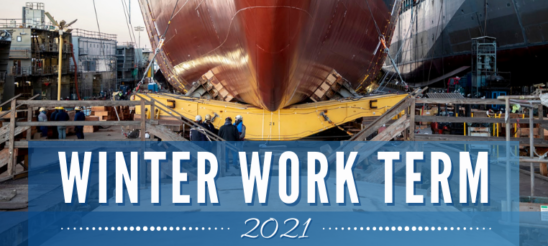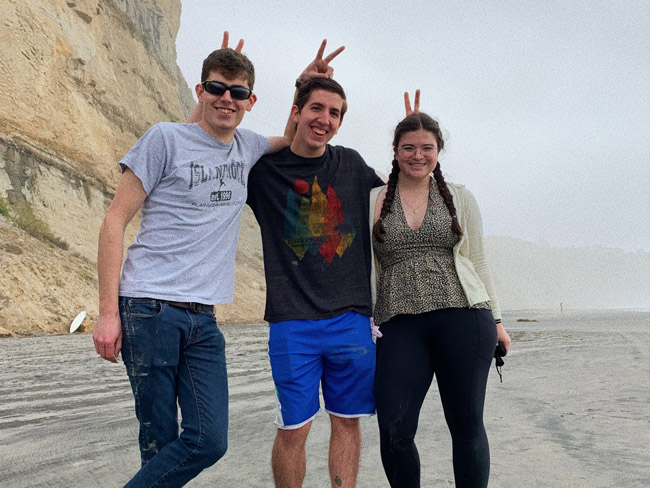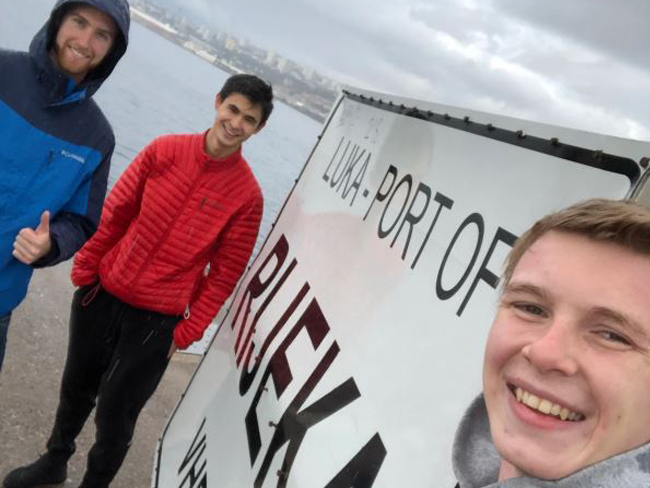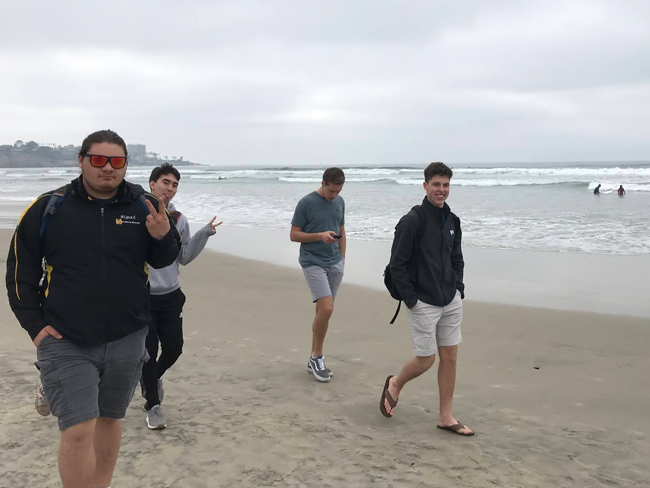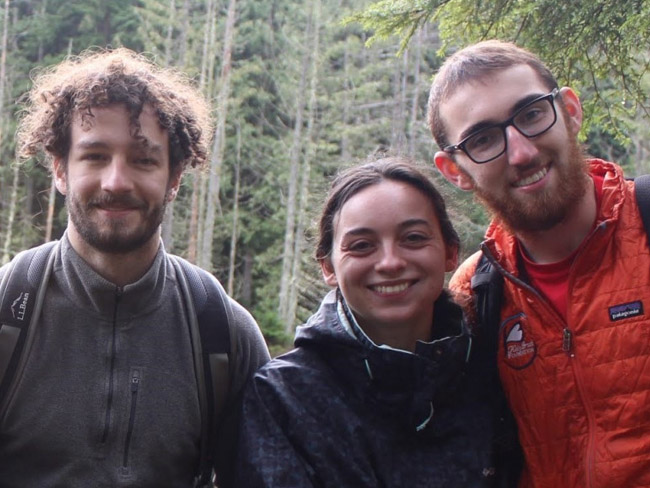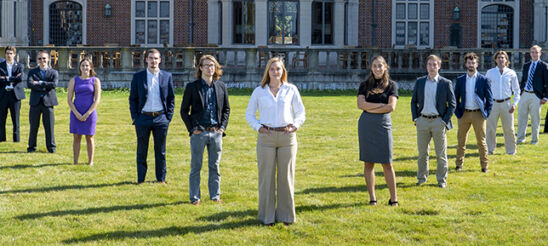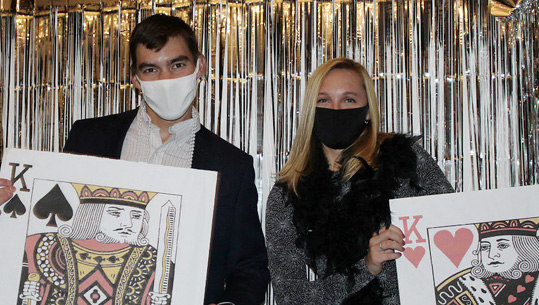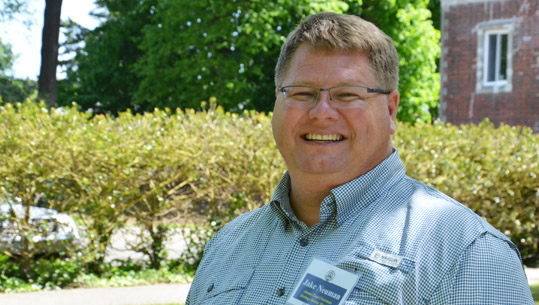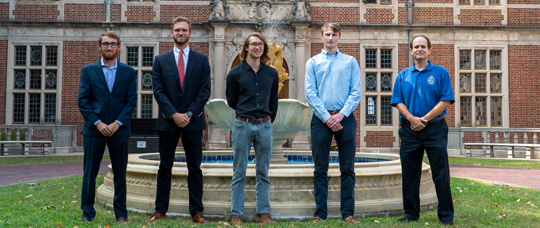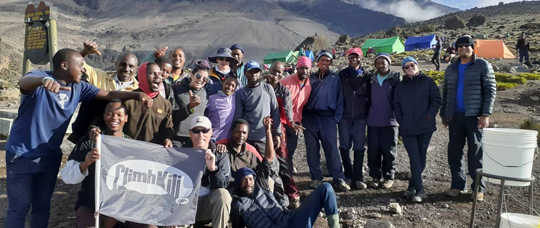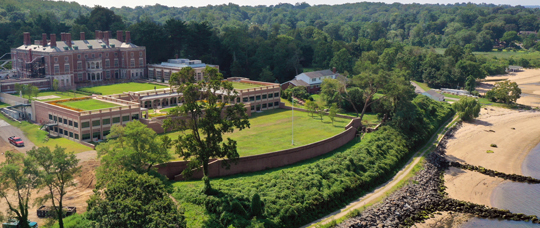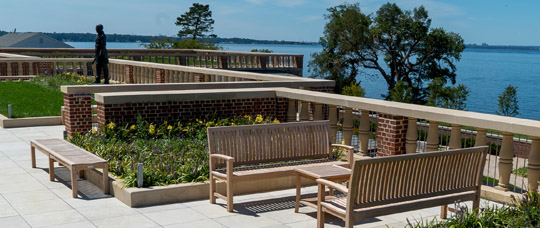During Winter Work term, our students spread out across the globe to gain real-life working experience.
Freshmen work alongside ship fitters and welders in shipyards. Sophomores serve as student observers aboard ocean-going ships to gain hands-on understanding and appreciation for the relationships between the marine environment, the shipping industry, the ship’s operators, and the ship’s design. Juniors and seniors network and apply themselves in design and engineering offices around the world.
Many thanks to the Webb alumni who reached out and offered jobs for Webb’s upcoming Winter Work Term. The upperclassmen were able to secure either remote or on site work, and all of the freshmen were placed in shipyards. The sophomores will not be sailing until the summer of 2021, but a good number of them were able to find work this winter in the maritime community. Thank you Jake Genauer ’10 and Vicky Dlugokecki ’88 for all your efforts.
See where our Webbies are this Winter Work Term!
Winter Work Blogs:
Stuck in San Diego: COVID Edition ’21
The following blog describes the not-so-spontaneous adventures and learning experiences of Dillon Esposito-Kelley ’21, Daniel Desio ’21, and Ioana Mirica ’22 while they intern at General Dynamics NASSCO in the winter of 2021.
Follow Jacob Dillistin ’23, Luke Kiely ’22, and Nathaniel Philips ’23 as they set out overseas to spend their Winter Work term at Metal Shark in Croatia.
This blog documents the experience of eight freshmen who will be working in two shipyards, Marine Group and General Dynamics NASSCO, in San Diego. Kohta Erdos, Kadi Zheng, Margo Bourn, Miguel Sanchez, Zach Doerr, and AJ Mills will be working at NASSCO, assigned to different departments. Tim Lazouski and Payne Donaldson are interning at Marine Group, a smaller shipyard that focuses on vessel repair.
Read about Alex Koziol ’21, Ben Hunt ’21, and Juliette Lehman’s ’22 Winter Work Term in Seattle, Washington. Ben and Alex will be working in the marine engineering and marine construction departments at Glosten, a marine consulting firm. Juliette will be working at Elliott Bay Design Group, which specializes in marine transportation.
Winter Work Term Companies:
Class of 2021
| BMT Designers & Planners, Inc. | Arlington, VA |
| Boksa Marine Design | Tampa, FL |
| Bruce S. Rosenblatt & Associates LLC | Newport News, VA |
| Colonna’s Shipyard | Norfolk, VA |
| Eagle Bulk Shipping | Stamford, CT |
| Excelerate Energy | The Woodlands, TX |
| GD NASSCO | San Diego, CA |
| Gilbert & Associates | Lenox, MA |
| Glosten | Seattle, WA |
| Herbert Engineering | Alameda, CA |
| HII Newport News Shipbuilding | Newport News, VA |
| Hinckley Yachts | Portsmouth, RI |
| International Seaways, Inc. | New York, NY |
| Martin Defense Group | Honolulu, HI |
| Northstar Midstream | Houston, TX |
| Oceaneering International, Inc. | Hanover, MD |
| University of Maine | Orono, ME |
| Vigor | Seattle, WA |
Class of 2022
| American Bureau of Shipping | Houston, TX |
| Aurora Marine Design | San Diego, CA |
| Bristol Harbor Group | Bristol, RI |
| DLBA Naval Architects | Chesapeake, VA |
| Elliott Bay Design Group | Seattle, WA |
| GD NASSCO | San Diego, CA |
| Gibbs & Cox | Arlington, VA |
| Great Lakes Shipyard | Cleveland, OH |
| Gulf Marine Repair | Tampa, FL |
| Hockema Whalen Myers Associates | Seattle, WA |
| Hydrocomp, Inc. | Durham, NH |
| Mercury Marine | Fond Du Loc, WI |
| Metal Shark Boats | Jeanerette, LA |
| Metal Shark Boats | Rijeka, Croatia |
| Murray and Associates, Inc. | Fort Lauderdale, FL |
| Northstar Midstream | Houston, TX |
| SERCO | Arlington, VA |
| Stolt-Nielsen Limited | Houston, TX |
| ThayerMahan | Mystic, CT |
| Universite de Pau et Pays d’Atours | Anglet, France |
| U.S. Marine Inc. | Gulfport, MS |
Class of 2023
| Aurora Marine Design | San Diego, CA |
| Bruce S. Rosenblatt & Associates LLC | Newport News, VA |
| Bruce S. Rosenblatt & Associates LLC | Newport News, VA |
| Global Secure Shipping | Old Town, ME |
| Matson | San Francisco, CA |
| Metal Shark Boats | Rijeka, Croatia |
| NEEC | Glen Cove, NY |
| NETSCo | Tampa, Florida |
| Persak & Wurmfeld | Brooklyn, NY |
| Quantum Marine Stabilizers | Ft. Lauderdale, FL |
| Shipwright LLC | Ft. Lauderdale, FL |
Class of 2024
| Austal, USA | Mobile, AL |
| Brookin Boatyard | Brooklin, ME |
| Caddells Shipyard | Staten Island, NY |
| Colonna’s Shipyard | Norfolk VA |
| GD NASSCO | San Diego, CA |
| Gulf Island Shipyard | Houma, LA |
| M. Rybovich & Sons | Palm Beach Gardens, FL |
| Marine Group Boatworks | San Diego, CA |
| Metal Shark Boats | Jeanerette, LA |
| Safe Harbor New England Boatworks | Portsmouth, RI |
| St. Johns Shipbuilding | Palatka, FL |
| Steigercraft | Bellport, NY |
| U.S. Marine, Inc. | Gulfport, MS |
The Class of 2021 Thesis Titles and Posters
In no particular order.
The Effect of Shape Change on the Added Mass Generated by an Axisymmetric Body
Jack Becker and Maggie Maguire
Added mass is the added inertia produced in a system when an accelerating body displaces the surrounding fluid particles as it moves through the fluid. In general, to achieve the added mass effect, the fluid or the object must accelerate, or the object must change shape. Cephalopods, such as octopi, can quickly and efficiently escape predators by expelling water through a cavity. This expulsion of water changes the shape of the body; moreover, it allows the creature to recover some of the generated added mass energy otherwise lost to the flow. The objective of this thesis is to analyze how shape change affects the added mass generated by an axisymmetric, deformable body to understand the performance capabilities of cephalopods.
An Investigation of Transom Stern Flow: An Evaluation of the Impact of Transom Radius
Alec Bidwell and Oscar Como
In the small-craft industry, a commonplace design standard has been to emphasize making the trailing edge of the running surface as fine and as hard-edged as possible. While it is time and cost intensive to laminate hulls with hard-edged running surfaces, it is understood that this characteristic greatly improves the handling of the vessel. On the contrary, rounding the trailing edge of the running surface has been understood to reduce performance characteristics of small-craft planing hulls. While these design characteristics are relatively known and understood within the industry, there has been no systematic testing on the topic. Additionally, the relationship between the transom radius and vessel performance has not been investigated in the context of larger, commercial vessels. We will be conducting a systematic series of experimental testing that will look at three different transom edge conditions in the application of a transom stern vessel. The three transoms include one with a 3/16” radius, one with a 1/8” radius, and finally one with a straight-edged transom. The stern wave profile and ventilation Froude Number will be determined for each transom plate, so that the effects of the various transom edge configurations can be accurately compared.
USCG LILAC Renovation: Developing a Plan to Carry Passengers on a Historic Lighthouse Tender
Ian Cosic and Cross Weeks
The USCG LILAC is a steam-powered lighthouse tender built in 1933. She is currently under the ownership of the LILAC Preservation Project which has shown interest in returning this historic vessel to service, utilizing her original equipment, to carry paying passengers on day trips up and down the east coast. Our task is to evaluate the vessel’s current intact and damaged stability and make recommendations on the least intrusive means of bringing her up to modern passenger vessel requirements for stability. This process will involve a full inclining experiment to be conducted on the LILAC. We will also evaluate the potential updates to the structure, firefighting, and lifesaving systems on board the vessel.
Airport Ferries: Feasibility Study and Concept Design of a New York Airport Ferry
Daniel Desio and Lina Tenenbaum
As a hub of commerce and traffic in the United States, the New York metropolitan area sees a large population that commutes in and out of the city. Timely and inexpensive transportation to airports is a necessity for commuters, and in New York City and the tri-state area, the travel to airports such as John F. Kennedy, LaGuardia, and Newark can be long and tedious. At the same time, the US market has become more favorable to ferry transportation. Given the higher demand for ferry transportation and the overall inefficiency of airport transportation, New York City could benefit from the inclusion of a streamlined and direct ferry service to the airports. Furthermore, our design can potentially incorporate onboard check-in and security before reaching the airport, which would provide timesaving benefits. This thesis will determine whether a ferry from New York City to one or more of the region’s airports is viable, both in terms of its cost and its timesaving capabilities. The results of the feasibility study will become requirements for a concept design.
Simulated Optimization and Feasibility of a Thermoacoustic Engine in the Marine Environment
Dillon Esposito-Kelly and Bret Sharman
Energy recovery systems have been attracting more and more attention over the past couple of decades. As technology has advanced, different methods, have been thrust into the spotlight. However, in recent years, focus has begun to shift towards the ecological footprint that these systems leave. With this focus in mind, a push towards a clean alternative of waste heat recovery has been in the forefront of future innovation. Thermoacoustic systems are one such method to achieve an environmental waste heat recovery system. We will be developing a computer-simulated thermoacoustic engine that will be applied to shipboard use to measure the efficiencies and compare the thermoacoustic engine with other waste-heat recovery systems.
The Design and Validation of the Equations of Motion of a Point-Wave Energy Converter Buoy
Ryan Flanagan and Inga Johansson
The demand for energy has been steadily increasing as global trade and the economy grow. Global interest in alternative methods of generating energy has been exponential in the 21st century. The next form of alternative energy generation to gain traction, as is apparent by the prototypes being launched in the United States today, are wave energy converters (WEC). According to the US Energy Information Administration, the approximate upper limit of energy potential in wave energy in our waters is 2.64 trillion kW-hr. The principal objective of this thesis is to validate the methodology developed in the thesis titled An Improved Methodology for PWEC Control System Design (Danilczyk and Petersen, 2007) This will be done by building and testing a linearly scaled buoy model in the Robinson Model Basin, using the wavemakers.
Design and Testing of Navigation Software for a Small Autonomous Surface Vessel
Max Haland
Autonomous Surface Vessels (ASVs) conduct missions with little to no direct human guidance. This is currently a very important field of development in naval architecture and marine engineering and will completely change the industry over the next several decades. One particular area of focus is the development of surveying and data-collecting ASVs. Small ASVs are ideally suited for many missions of this type. Using them can lead to huge reductions in cost and staffing, and swarms of ASVs coordinated by a staffed mothership are currently being developed and tested by several different groups. Webb Institute has a very small ASV built by Isaac Kremers for his 2017 thesis. So far, the Webb ASV has not been developed sufficiently to use as equipment for other theses. The objective of this thesis is to develop navigation software for the Webb ASV so that it can be used for future theses.
The Viability of Compressed Natural Gas as Fuel: The Installation and Emissions Testing of a Dual-Fuel System for an Electronically-Timed High-Speed Diesel
Sean Healy and Luke Herbermann
In recent years, strict emissions regulations have created a challenge for the shipping industry. One of the ways to help ships abide by these regulations is to convert an existing engine to run on dual fuel. Running on dual fuel in our case means running on a mixture of about 30% diesel and 70% compressed natural gas. Our thesis is a continuation of several theses that attempted to convert an existing diesel engine to run on dual-fuel. The objective of this thesis is to use this engine and run emissions testing on it to see how well the dual-fuel system works.
Metaheuristic Algorithms in Concept Design: Optimization of Marine Electrical Systems
Ben Hunt and Alex Koziol
Ship designers have long used experience and standards to guide their solutions to problems. Automation and modern optimization software, despite their limited exposure in the maritime industry, could significantly reduce this effort, as well as help designers make trade-offs between new technologies. We are developing software that will transform an Electrical Plant Load Analysis table into a fully-defined One-Line Diagram with distribution components. From this base, algorithms are developed to optimize system layout and power production techniques for fuel use and emissions with respect to various operating conditions. This design tool will prove valuable for the Concept Phase of ship design, allowing engineers to draft and evaluate options quickly and easily.
Ride the Wind: A Seakeeping Study of the Gyroscopic Effect of the Wind Turbine Rotor on a Moored Tension Leg Platform
Jackson Juska and Addie Lindyberg
A Tension Leg Platform is a floating platform that provides stability using tensioned tendons anchored to the ocean floor. Offshore wind turbines use these because they are considered very stable; however, the gyroscopic effect of the turbine rotor introduces a new inertial element on the platform, which is not yet fully understood. The objective of this thesis is to study the inertial effect that the rotating blades of a wind turbine will have on the motion of a Tension Leg Platform in incident waves. To do this, we will design, build, moor, and test a turbine in the Robinson Model Basin.
A Preliminary Design of a Navy Hospital Ship to Include Epidemic/Pandemic Rapid Response
Shannon Liu
In the fight against COVID-19, the US government employed as many techniques as possible, including the deployment of the Navy’s two hospital ships to each coast. These ships were designed decades ago to provide tactical medical support, but since have been used more often for humanitarian aid and disaster response missions. The Navy has been working on replacements for these vessels, and such a design should reflect the new types of missions that Navy hospital ships have been completing. This thesis will include a design that supports rapid response for infectious disease control and treatment.
An Experimental Analysis of the Effect of Moonpool Recess Geometry on Added Resistance
Robert Maes and Henry Rouland
Moonpools are openings in ship structures that provide access to water from inside the ship. Added resistance from a moonpool is generated when a ship has forward velocity. In 2012, Samsung Heavy Industries (SHI) received a patent describing four different geometries for aft moonpool recesses designed to reduce the added resistance in a 96,000 DWT deep-water drillship. In 2019, Will Harris used a series of numerical simulations on a Series 60 hull fitted with a moonpool to derive values for the resistance reduction of each SHI moonpool geometry over a range of Froude Numbers. The objectives of this thesis are to investigate the effects of moonpool recess geometry on added resistance and to validate Harris’s analyses. Using Harris’s test matrix, experimental values for the resistance reduction will be derived through model testing in Robinson Model Basin. In addition to providing experimental data, the results of the experiments will be compared to Harris’s numerical results, providing insight into relationships between numerical and experimental evaluations of moonpool resistance and behavior.
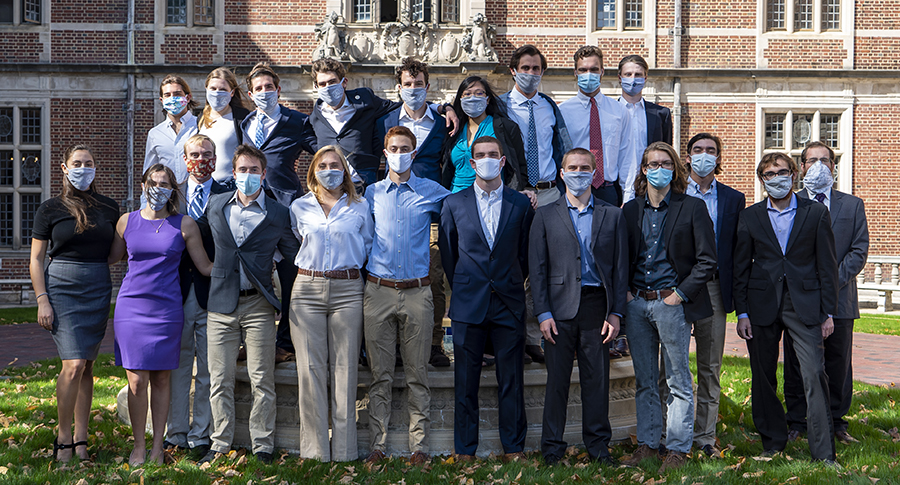
Big Winners and High Rollers at Casino Night
by Reed Stevenson ‘24
The 2020 Webb Institute Casino Night was filled with big winners and high rollers. Despite the restrictions in place due to COVID-19, the Student Social Committee (SOCO) was able to once again turn Stevenson Taylor Hall into a roaring casino, filled with plenty of games. Many students made thousands off their original 500 Webb bucks, a currency inspired by our wonderful faculty members, in games such as blackjack, poker, horse racing, roulette, and Plinko.
The evening made its way outside to the Webb tennis courts where the annual three-person horse race took place. Each class put forth a team to hopefully take home first place. With all bettings closed, the horse race began. Immediately out of the gate, the sophomore class took the lead, followed shortly by the juniors and seniors with the freshmen bringing up the rear. Each team but the sophomores had troubles keeping their horses intact, allowing for the sophomores to keep up their lead. They ended up blowing away the competition with the seniors coming in a distant second and the freshmen not far behind them. The juniors stumbled across the finish line well after the other teams had finished.
The next event was run by the seniors, where they attached a spring and handle to an oil drum to create a makeshift mechanical bull. Many tried and were flung away by the bucking oil drum. Luke Sullivan ‘23 used a unique tactic of holding on to the rear of the “bull” to secure the longest time.
The next event of the night was the arm-wrestling competition. Many competitors lined up to show off their physical prowess and prove their might in the tournament. David Ockers ‘22 secured the title of Webb arm-wrestling champion in a stunning display of strength.
Overall, casino night was a great success. Many students were able to win big and spend their winnings on the silent auction held throughout the night which would not have been possible without SOCO.
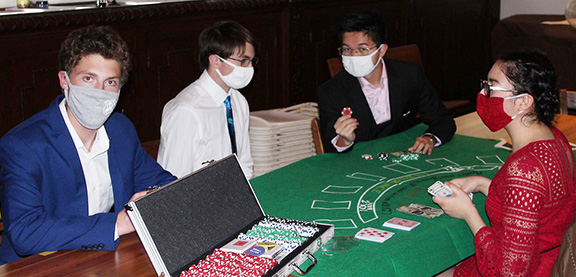
Solid Performance in the Midst of Change and Uncertainty!
by Jake M. Neuman ’93
Chairman of the Webb Alumni Fund
At first glance, the 2019-20 Webb Alumni Fund (WAF) total raised of $2,027,089 might seem underwhelming with the backdrop of the successive record-breaking WAF years. But when you consider just how different this giving year was from most, reaching the $2 million plateau was a difficult task, one that could only be accomplished through your generous gifts during these uncertain times. When we planned for this WAF year, we knew all too well that you have been asked to stretch your giving capacity during the six-year Campaign for Webb effort. Then unexpectedly, in the last quarter of the giving year, COVID-19 disrupted our lives.
Most Webb students learned remotely during the spring semester. Many alumni experienced professional hardships. Our Spring Phon-a-thon was replaced by Webb Cares—phone outreach conducted by Webb students to ensure everyone’s well-being—a great display of the Webb family values. In spite of all of the challenges, alumni, led by class agents, persevered and contributed over $2 million of much-needed support for Webb. This is only the fourth time in Webb’s history that the WAF has surpassed $2 million, and for added context, the WAF secured $1.3 million in the first year before the Campaign for Webb (2013-14). In short, I am proud of what my fellow alumni have accomplished, but I would not be doing my job unless I shared with you that I think we can do even better next year! THANK YOU to all who continue to make the WAF a pillar of Webb’s financial support.
| 2019-2020 | 2018-19 | |
|---|---|---|
| Total Funds Raised | $2,027,089 | $2,561,658 |
| Participation % (Webb undergraduates Only) | 70.4% | 71.6% |
| Participation % (All Members of the Webb Alumni Association) | 68.0% | 69.4% |
| Average Gift | $2,553 | $3,190 |
| Median Gift | $750 | $720 |
Together, we achieved a nation-leading undergraduate participation rate of 70.4% and 18 Webb classes boasted an amazing 100% participation rate. Our future is bright, too, as the most recent 15 graduating classes combined for an average participation rate of 86%.
I look forward to a great WAF 2020-2021 as we strive to raise $2,100,000 and secure the participation of 75% of undergraduates.
A huge thanks to the Class Agents, Group Leaders, and the Development Office for all their time and efforts for the Webb Alumni Fund. The success of the WAF truly is a team effort! Thank you! A special thanks to Paul Hayes ’54 who is handing over Class Agent title to Joe Signorelli ’54 and welcome to our newest class agent, Reneé Tremblay ’20!
You can have a big impact on the future of our fundraising success and Webb’s financial well-being by:
- Maximizing your current giving levels – The WAF average gift is $2,553 and the median gift is $750. Maybe these are goals you can strive for or comfortably exceed, depending on your circumstances.
- Giving as early in the giving year as possible – This allows everyone involved in this effort to spend more time cultivating alumni that either do not give regularly or have not yet given at all.
- Serving as an ambassador for the WAF and Webb – Help your fellow class agents by encouraging classmates to maximize their giving and to give as early in the giving year as possible. Sharing your giving strategies (monthly giving, gifts of stock, gifts leveraging donor advised funds, charitable distributions from your IRA, matching gifts, etc.) may inspire a new gift or help your peers achieve new giving levels!
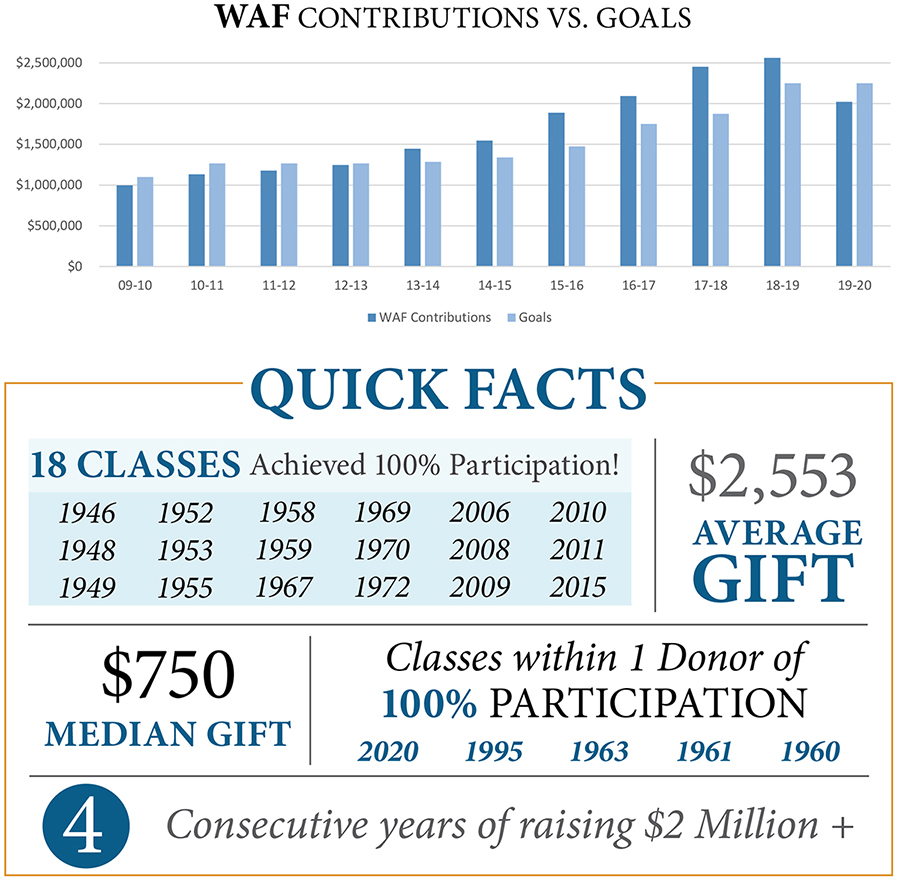
Webb’s Ongoing Commitment to Diversity, Equity and Inclusion
At its annual meeting on October 15th, the Board of Trustees reaffirmed its commitment to promoting diversity, equity, and inclusion at Webb. The Board’s DEI Committee, formed in 2019 to help inform DEI-related initiatives in Webb’s Strategic Plan, is tasked with presenting a DEI Plan to the Board at its February 2021 meeting. The plan is to contain actionable and accountable initiatives that will expand diversity of students, faculty, staff, and Trustees and provide a pathway towards a more equitable and inclusive campus environment.
At its meeting, the Board unanimously approved the following resolution.
The Board’s DEI Committee, chaired by Trustee George Campbell, is comprised of constituents from the board, administration, faculty, staff, alumni, and students. To better understand the climate at Webb and the needs of our underrepresented populations, the Committee will conduct surveys and listening sessions with students. The Committee invites discourse and discussion on DEI and will host online forums with students, faculty/staff and alumni. Announcements on dates for these forums will be sent out over the next couple of weeks.
The Board and the Administration recognize that not all members of our community have enjoyed the nurturing and supportive experience we aspire to. Our commitment to a more diverse and equitable campus environment is driven by our common understanding of the importance that the perspectives of a diverse population play in the academic process as well as our aspiration to provide a welcoming campus environment where every student, faculty and staff member can fully realize their capacity to grow and learn. The Trustees and Administration at Webb look forward to working with all of you as we commit ourselves to enriching the diversity and inclusivity of the Webb campus community.
| Bruce S. Rosenblatt Chair, Board of Trustees | Dr. George Campbell Chair, DEI Committee | R. Keith Michel President |
Four Webb Students win the Dr. James A. Lisnyk Student Ship Design Competition
(Pictured left to right: Benjamin Hunt, Oscar Como, Luke Herbermann, Alec Bidwell, and Professor Bradley D.M. Golden ’99)
By Professor Bradley D.M. Golden ’99
It is our pleasure to announce that Alec Bidwell, Oscar Como, Luke Herbermann, and Benjamin Hunt have won first place in this year’s SNAME Dr. James A. Lisnyk Student Ship Design Competition for their design of an LNG Bunkering Vessel. The vessel was originally designed for last semester’s SD1 course and, with only a few minor additions to their analysis, they were able to submit the same design for the Lisnyk competition.
A challenging enough project during a “regular” semester, all six groups successfully completed their designs while scattered across the country due to the COVID-19 pandemic, and all of them did very well. Alec, Oscar, Luke, and Ben went above and beyond and put in the extra effort that was required to meet the demands for the SNAME competition, and I’m very happy to see that all their hard work paid off.
According to the SNAME website, “The Lisnyk Student Ship Design Competition challenges groups of young people to design theoretical but practical cutting-edge vessels. Open to the world’s colleges and universities supporting maritime careers, the program has fostered teamwork and learning through competition.”
Dean Werner would like to add, “Congratulations to the Team, Professor Golden, and the industry advisors. The design and its presentation were very well done and quite worthy of the honor. It is always rewarding when outside groups recognize the excellent work of our talented Webb students. I hope that members of this year’s junior class see this as inspiration to enter their SD1 designs in one of the various design competitions available.”
To make this award even more special, Dr. Linsnyk was a Webb graduate from the class of 1963.
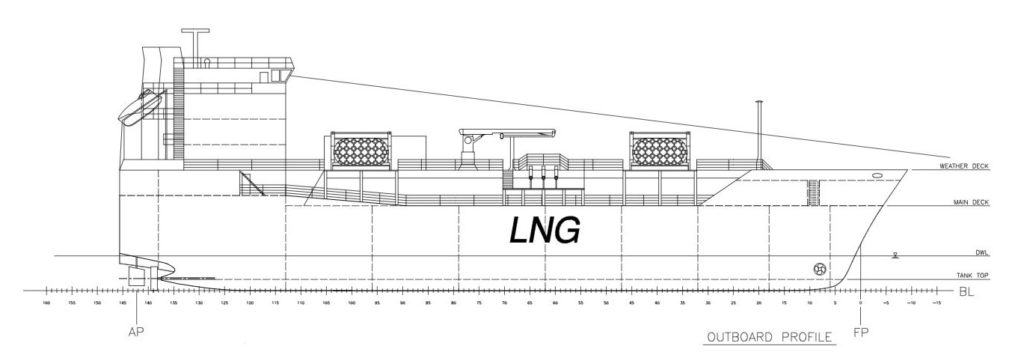
4,200 M3 LNG Bunkering Vessel
About Dr. James Lisnyk ’63 (Portions from “A Centennial History of Webb Institute of Naval Architecture”)
Born in Jamaica, New York Dr. Lisnyk was a graduate of Webb Institute of Naval Architecture. Attended MIT as SNAME Scholar receiving a MS in Naval Architecture in 1964 and joined BuShips. He earned a D.Sc. degree in Engineering Management from George Washington University in 1977. Then transferred to MARAD as Program Manager for Advanced Ship Systems then becoming Acting Director, Office of Maritime Technology in MARAD’s Office of Research and Development. Authored numerous technical papers for ASNE and SNAME; served on SNAME and ASNE governing boards; was Chairman of SNAME’s Chesapeake Section and VP of that Society. Elected VP of the Webb Alumni Association. Returned to NAVSEA in 1980, as Chief Naval Architect and Deputy Director, Hull Division. Awards include, the Department of Commerce Bronze Medal and SNAME Spring Meeting Paper Award 1979. Dr. Lisnyk was honored posthumously by having an ASME scholarship named in his memory; the Chesapeake Sect. Established the James A. Linsyk Student Design Competition Award; and NAVSEA’s Association of Senior Engineer’s named its award for its outstanding young engineer after him. Married Bridget DiGesu in 1964; two children Linda and Amy.
Tragically, he and his daughter were killed on August 1st, 1984 in an automobile accident. Dr. Lisnyk’s wife Bridget and another daughter were injured in the accident but survived.
About the Junior Class Small Vessel Design Project (SD1)
As a part of Professor Bradley D.M. Golden’s ’99 Ship Design 1 (SD1) class, the juniors spent the first two-and-a-half months of the spring semester preparing their first complete concept designs.
Using the knowledge they’ve gained in their nearly three years studying at Webb and the experiences from their winter work periods to date, this was the students’ first opportunity to apply the naval architecture and marine engineering principles they’ve studied including stability, ship’s structures, main machinery systems, auxiliary systems, resistance and propulsion, and electrical engineering.
Working in small groups of three and four, the students selected one of the vessel types and took their first couple of spins around the design spiral to prepare vessel concept designs. To help make the project as realistic as possible, members of industry familiar with each of the vessel types helped prepare the statements of design requirements that each of the designs had to meet. To challenge the students even further, one or two “curveballs” were thrown into each design statement to make the students think long and hard about how they would achieve their objectives.
At the end of the spring semester, the students presented their final designs to their fellow students, faculty, and members of industry who served as part of an evaluation team. After three years at Webb, the Junior class can now say with confidence that they’re familiar with the design process and are well on their way to joining the fields of naval architecture and marine engineering.
About SNAME:
The Society of Naval Architects and Marine Engineers (SNAME) was organized in 1893, to advance the art, science, and practice of naval architecture, shipbuilding and marine engineering. SNAME is an internationally recognized non-profit, professional society of individual members serving the maritime and offshore industries and their suppliers. For many, SNAME has been absolutely essential to career development and success in the industry. With more than 6,000 members around the world in 95 countries, SNAME is THE International Community for Maritime and Ocean Professionals! For more information, please visit: https://www.sname.org/
Rick Royce and the Mountain of Terror
by Rick Royce as told to Rick Neilson ’70
As seen in Webb News 2020 edition
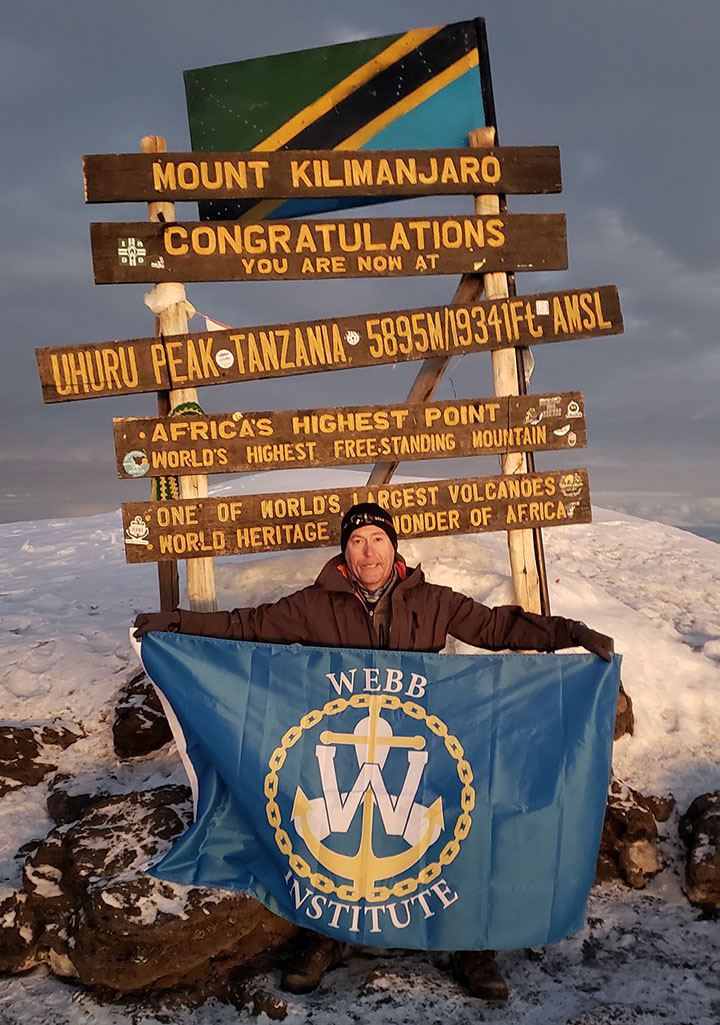
Richard A. (Rick) Royce has a Ph.D. in Naval Architecture and Marine Engineering from the University of Michigan and serves as Professor of Naval Architecture at Webb Institute, having been hired in 2001. In addition to his classroom duties, he has performed many different services, including Director of Research; Director of the Robinson Model Basin; leading the Webb “big boat” sailing efforts, including the Newport, R.I. to Bermuda race; and Principal Investigator for the Office of Naval Research (ONR) Navatek Consortium. Under Roger Compton’s leadership, Rick was a major author of the proposal to ONR that secured $2 million in grants for upgrades to the model basin, marine engineering laboratory, and the purchase of a research quality flow channel, in addition to funding research. Rick did a great job managing the resulting funds. In the time I’ve known Rick I have always thought of him as extremely capable and a reasonably sane man. Then I learned that in January of 2020, he planned on climbing Mount Kilimanjaro. Sometimes one has to re-think his opinion of another’s mental stability.
Spending a lot of time in a building the students often refer to as Hogwarts can do strange things to people. Perhaps that is what caused the aberration in the good professor’s mind though he claims this was a long time coming. The real impetus for this adventure came from Rick’s sister, Karen. They have always been close, and Karen wanted to do something special for their upcoming birthdays. So in the summer of 2019 they considered several options, but none seemed quite right. Karen was a geology major and had helped run field camps, as well as having spent extensive time on the Appalachian Trail. She had friends who had taken some African safaris, and she was the one who suggested climbing Mount Kilimanjaro. Rick had done some mountain climbing as far back as college. In the late 1990s he had climbed Mount St. Helens, carrying his skis up and skiing down. Rick’s ex-college roommate worked for Christensen Shipyard in Vancouver, Washington, and when Rick visited him, they would go climbing, including Mt. Adams and Mt. Hood. So Karen’s suggestion didn’t sound crazy. There are a number of companies that arrange a Kilimanjaro climb and after some research, they decided on a company called “Climb Kili.”
Rick knew he had to prepare. He started doing cardio on elliptical trainers in August then threw in some hiking locally, including walking the dog with a full backpack each morning. During Thanksgiving week he went to England, Wales, and Ireland. He did a lot of walking that week and climbed Mt. Knocknarea near Sligo, Ireland, which is only 1,000 feet tall but is steep.
Climb Kili provided an agenda for an eight-day trip that required their arrival on January 10, as well as some instructions. Because the park system limits the weight for porters, each hiker is allowed his or her own personal gear plus a maximum of 15 kg of “extra gear,” which an assigned porter carries. Costs cover transfers to and from Kilimanjaro International Airport, which is located between the cities of Moshi (population approximately 200,000) and Arusha (400,000). Karen and Rick flew from JFK airport and splurged on upgrades to business class, figuring it would be their last chance to be pampered for a while. Upon arrival they were taken to a hotel which was good quality though surrounded by a wall and razor wire.
The group consisted of six climbers, three men and three women. Karen lives in Dublin, Ohio. Besides Rick, the other climbers were from Los Angeles; San Francisco; Edmonton, Alberta; and north of London, England. There were three guides, a cook, a waiter, a dishwasher, a toilet attendant, and 13 porters. Each climber had one porter to carry personal gear such as sleeping pad, sleeping bag, and extra clothes. The remaining porters carried food, tents, and campsite gear.
The actual climb started on January 11 at an altitude of 5,000 feet, where the temperature was between 85 and 90 degrees F. Rick says that as opposed to the mountain climbing one might envision, most of this trek was a slight rise with only a few steep portions. They started at the end of the rainy season although the first day was fine weather. The second day they hiked in the rain. They experienced no other real rain but often climbed in a mist. Each morning they were awakened by the waiter, Balthasar, and his “smooth jazz voice” at 6:30. Then they would pack up their extra gear for porters to carry and prepare their day backpack with two to three liters of water, rain clothes, snacks, trekking poles, hat, gloves, and rain cover for packs. Breakfast would be served around 7:15 and was usually pineapple, porridge, eggs, toast, and diced sausage. While eating, they would have their pulse and oxygen content measured. As long as their O2 level was above 75% they were good to go. If not, there was always the option of staying behind with a guide and catching up later in the day, or having a guide lead the person down the mountain. Guides and porters were always saying “Pole Pole” (poley poley) which means “go slowly.” This allowed porters to pass the climbers on the trail so they could get set up at the next camp, and for those not used to the altitude, the slow pace prevented burn out. The guides and porters were constantly mindful of the physical condition of the climbers and from that point of view they always felt safe. They would leave camp around 8:00. The length of climb varied by day. When they arrived at the next camp, they would have lunch, starting with soup, toast, pineapple, chicken or fish, and potatoes. Then they would unpack their gear and get their tent, air mattress, and sleeping bag situated. Rick would usually walk around quite a bit to make sure he could sleep through the night. Dinner was at 6:30 and consisted of soup, rice, or pasta with stir-fried veggies for topping, potatoes, and fritter type deserts. Rick thought the food was surprisingly good. Hunger may have seasoned it.
Bathroom facilities were less than lavish. The middle-to-high-end tour companies have a toilet attendant. This person carries a portable toilet and tent for the climbers to use. When breaking camp the attendant empties the contents into the bare-bones toilets provided on the mountain. “Bare-bones” means “bare-bones” – think of an outhouse but with no bench seat, just a hole in the floor and the aroma reminiscent of the senior classroom after a ship design all-nighter.
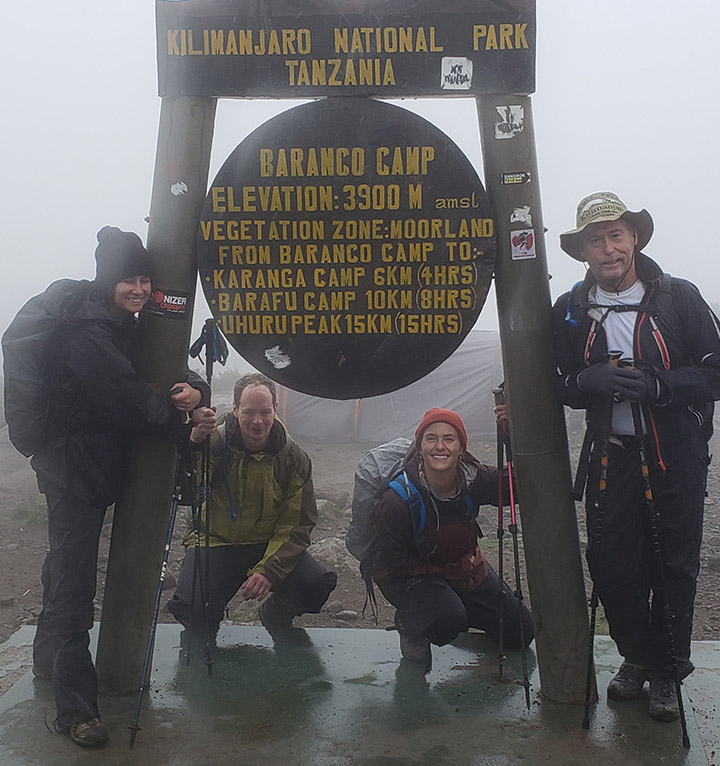
There was one dangerous portion of the climb – a stretch at the Great Baranco Wall. It is an 800-foot rise on a switchback trail with a 60-foot drop-off on one side. Handholds were definitely needed there. Rick did see one person evacuated from the mountain. He was brought down on a gurney of sorts that had only one wheel in its center. It looked extremely uncomfortable but it was the only way available to get someone to one of the mountain’s helipads.
Some highlights of the climb included seeing buffalo tracks at 13,000 feet where there are salt deposits for the buffalo to lick. They stopped at the Moira camp at about 13,300 feet that night although the guides wanted them to go higher where they could get cell phone service. On day seven they started at 16,000 feet around midnight. Rick never considered quitting but the penultimate stretch of the climb to Stella Point at 18,875 feet was quite steep and he felt a bit light-headed. Guides carry oxygen for those climbers who need it, but once they take it, they are required to go back down. After a brief rest, Rick felt fine and the remainder of the trek to the summit at 19, 341 feet involved only a slight rise. They arrived at 6:05 am. It was -10 degrees F. They only stayed 30 minutes at the summit because the sun was coming up and there was a real concern about snow blindness. On the route they took, an average of 70% of the climbers achieve the summit. Not all of the climbers in Rick’s group were able to make it, but all had an experience to remember.
The trip down was a bit anti-climactic. They went by a different route, having climbed the northwest side of the mountain and descending the southwest side. It was certainly quicker than going up, but it was tougher than Rick thought it might be because the descent required the use of different muscles. They left the mountain at 5,000 feet and spent the night in the hotel. Having anticipated the need for a bit of R&R, Karen and Rick flew to Zanzibar for a stay at the Diamonds Mapenzi Beach Resort. This required local currency, so Rick went to get some Tanzanian shillings. The machine he used had a menu asking how many he wanted and not being familiar with the exchange rate, he chose 30,000. Turns out that is equivalent to about $12 US. The exchange fee was $7 US. Next time Webb’s Director of Research will do more research ahead of time.
So what did Rick accomplish on this trip? First, he lost about 10 pounds despite the hi-carb diet. Secondly, he most probably is the first person to drink a Diet Coke at the summit (Rick refused to confirm or deny this with me), and finally, he is not only the first Webb prof to climb Mount Kilimanjaro, he is certainly the first person to unfurl a Webb banner on the summit. Congratulations are in order. I can’t wait to hear what he does next winter. If he invites me, I’m busy that day.
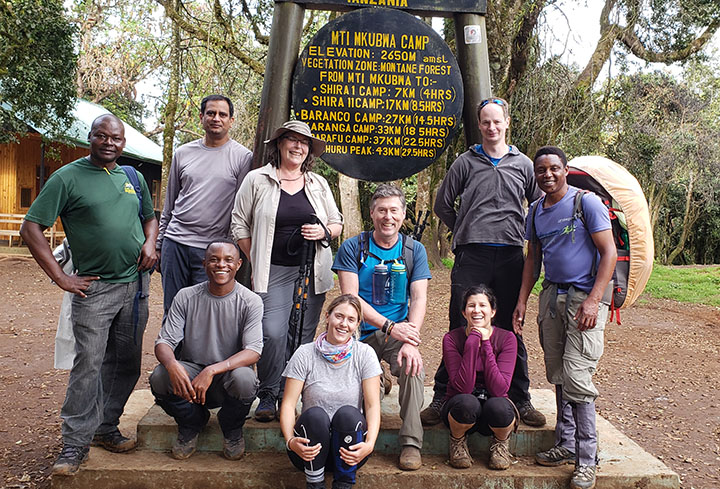
Photo Credit: Climb Kili
A Message from President Michel
Webb prides itself on a culture built upon respect and generosity. These principles are embedded in our honor code and flow down from our founder William H. Webb. We strive to embrace our differences and through dialogue and collaboration, build a campus community where everyone feels appreciated and empowered. Notwithstanding our best efforts, we sometimes fall short of these goals. The key is to make sure that those times serve as learning experiences, encouraging us to redouble our efforts to ensure a welcoming environment where each student can flourish. At Webb, we recognize and value the role that diversity and inclusion play in enriching the educational experiences and quality of life of our students. As Board chair Bruce Rosenblatt explained in a recent email to the Webb community, our collective aspiration to enhance diversity and inclusion are incorporated in our Strategic Plan and have led to changes in our Admissions processes and scholarship programs. Our students, alumni and staff have offered suggestions for new initiatives for advancing inclusiveness on campus. I promise that we will carefully consider each of these ideas as we develop actionable plans in the coming months.
In 2017, the Board established a Diversity Committee tasked with informing the Board’s discussions on diversity and related strategic planning objectives. The Committee’s newly appointed chair, Dr. George Campbell, has a long history of advocating for diversity, equity and inclusion in higher education. George is past president of Cooper Union and his wife is currently president of Spelman College. The Committee’s membership includes Trustees, the president of the Alumni Association, the President and Dean, staff and students. The Committee will work collaboratively with the Administration and report regularly to the Board. The charge of this Committee includes:
- developing a Diversity and Inclusion Plan that builds upon ongoing initiatives,
- promoting surveys and listening sessions, to ascertain the views and ideas of all Webb constituencies and to understand their needs,
- helping to prioritize our actions, and,
- evaluating metrics to ensure accountability.
Higher education has a critical and necessary role in building a more equitable and tolerant society. At Webb, our first step is to reaffirm our commitment to seeking out the distinctive viewpoints that come from a diverse population, including differences in race, religion, gender and socioeconomic status. I look forward to learning from all of you and being an advocate for change, as we work to make a difference on the Webb campus and in our broader community.
Please post your ideas on the Community Portal or directly contact me or other members of the Webb community. In the interest of privacy, I ask that you please avoid mass emails.
Thank you for your interest and continued commitment to Webb and our mission.
A Message On Diversity, Equity and Inclusion at Webb
Webb Institute is committed to diversity, equity, and inclusion. Below is a message from the Chairman of the Board of Trustees, Bruce Rosenblatt, about Webb’s current initiatives and strategic plan.
A MESSAGE ON DIVERSITY, EQUITY AND INCLUSION AT WEBB
The topics of diversity, equity and inclusion have been an ongoing commitment of the Webb Institute Board of Trustees and Administration and are common themes throughout the recently adopted Webb Strategic Plan. Recognizing that inclusivity, mutual respect and integrity are fundamental to Webb’s Mission, the Strategic Plan calls for consideration of diversity and inclusion in all aspects of Webb governance and operations, including the makeup of the Board, faculty, staff, and student body.
Two goals of the Plan that relate to enhancing the diversity of the student body are:
“To develop a comprehensive student recruitment program to ensure a highly-qualified, diverse student body in future years”, and,
To meet the demonstrated financial need of every student, in keeping with Williams Webb’s goal of serving students with limited resources.”
A significant step towards progressing our commitment to diversity in the student body was the hiring of Lauren Carballo as Director of Admissions and Student Affairs. Being one of the few non-English speaking, Hispanic students in her elementary school, Lauren has personal knowledge of the challenges that young people with differing backgrounds face growing up. Early in life, she developed a passion for promoting diversity, equity and inclusion – a trait that has served Webb and our students well. In her four years at Webb, Lauren has reinvigorated our student recruitment processes
Some recent initiatives aimed at increasing the number of underrepresented students at Webb include:
- building bridges to organizations and high schools with large populations of underrepresented students,
- placing greater emphasis on applicants overall academic records, strength of character, extra-curricular and leadership interests, and less emphasis on SAT/ACT scores, and,
- establishing a room & board scholarship program to meet demonstrated financial need. This program originated with a grant from the Robert D.L. Gardiner Foundation. Over 200 gifts from alumni and friends of Webb have been received over the last three years as we seek to establish permanently endowed scholarship funds to perpetuate the program.
These initiatives are already reaping rewards, with significant increases in the number of minority and socio economically disadvantaged students being realized in recent years. For example, the percentage of ALANA (Asian American, Latino American, Native American, and African American) students in the freshmen class has averaged 28% over the last two years, up two-fold from the ten-year average. Similarly, underrepresented minorities (Latino, Native American and African American) comprise 12% of these classes, up three-fold. We are pleased with these improvements in the diversity of our student body while recognizing that there is more that we can do.
The aforementioned initiatives have been a factor in the steady increase in the application pool and the qualifications of our freshmen over the last five years. At the same time, we have achieved record graduation rates and now boast a student body of 101 students. Of particular significance, the graduation rates of our women and ALANA students have been comparable to or higher than their counterparts. These outcomes are consistent with research indicating the superior performance of diverse communities.
We continuously strive to provide a Webb experience that is safe and enjoyable for all students, regardless of their race, national origin, gender, or religion. Goals in the Strategic Plan related to equity and inclusivity include to:
“Reinforce the strong moral and ethical awareness of Webb students, and the principles of Webb’s Honor Code, so that the college is regarded as a model of inclusivity, respect and integrity”, and,
“Develop programs that further raise the cultural awareness of the student body, faculty and staff, and provide support for the different needs of a diverse student body.”
A number of student clubs provide support for the minority populations at Webb. External speakers on diversity/acceptance/inclusion are invited to present their ideas at Leadership Week. Earlier this year, a webinar hosted by Lauren Caballo on the topics of diversity, equity and inclusion garnered participation from three-fourths of the student body. Psychologist Dr. Michelle Stein has become an integral part of our efforts to enhance student health, meeting weekly with Webb students to discuss all aspects of student wellness.
A year ago, the Board of Trustees established its Diversity Committee, with trustee, faculty, staff, and student representation. Chaired by Jen Waters ’91, the Committee is tasked with exploring ideas on enhancing diversity and inclusivity at Webb. The chairmanship of the group has recently transitioned to Dr. George Campbell. This Committee will be reporting to the Board at its regular meetings and tracking our progress in enhancing diversity, equity and inclusion at Webb.
We are constantly on the lookout for new ways to improve the environment at Webb. Should you have suggestions, please do not hesitate to contact Board Chair Bruce Rosenblatt at ude.bbew@ttalbnesorb, President Keith Michel at ude.bbew@lehcimk, or Director of Admissions and Student Affairs Lauren Carballo at ude.bbew@ollabracl. Should you wish to assist in these efforts by visiting high schools in your region, let us know. The “demonstrated need” scholarship program has been a resounding success but needs more resources. Should you wish to contribute to this effort, please contact the Director of Development Anthony Zic at ude.bbew@ciza.
We are hopeful that our Homecoming in May can be an in-person event. If so, please join us on campus and exchange ideas with our students, faculty and staff on these important issues.
Sincerely,
Bruce S. Rosenblatt
Chairman of the Board of Trustees
Webb Institute
Alumni Spotlight: Arthur W. Schmidt ’48
Maintaining the Webb Legacy
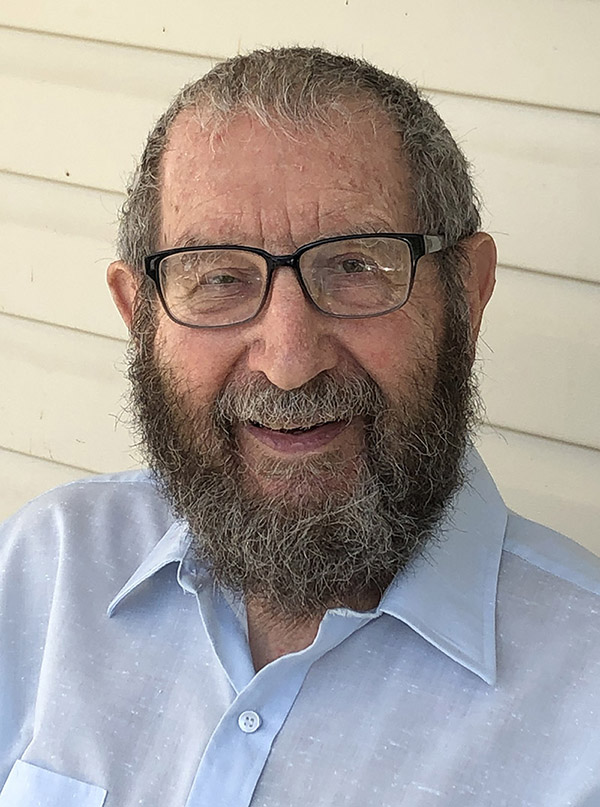
This is not an achievement of mine, but just one case, out of 1,722 graduates so far, of achievement of William Webb. After graduating from Brooklyn Tech High School in 1942, I was drafted into the Navy, and spent a year at sea. I was a Quartermaster 2nd class on the Luzon ARG-2, a cargo ship converted into a repair ship in Baltimore. I helped put it in commission in 1943. Using the V-12 program, my captain then sent me back home, to attend college and become an officer. Mr. Webb provided a castle in the Bronx to play games and do homework in the towers. At the castle, I remember Admiral Rock the administrator, who was tall and thin with a thick head of white hair, and a loud whistle to warn the neighborhood kids “to get off my property.”
Read more…
